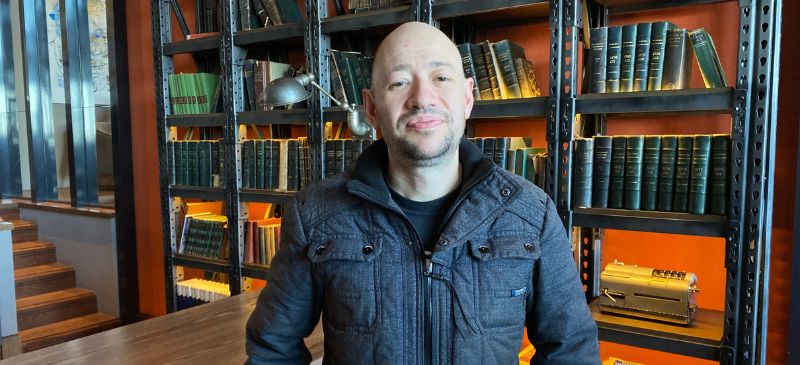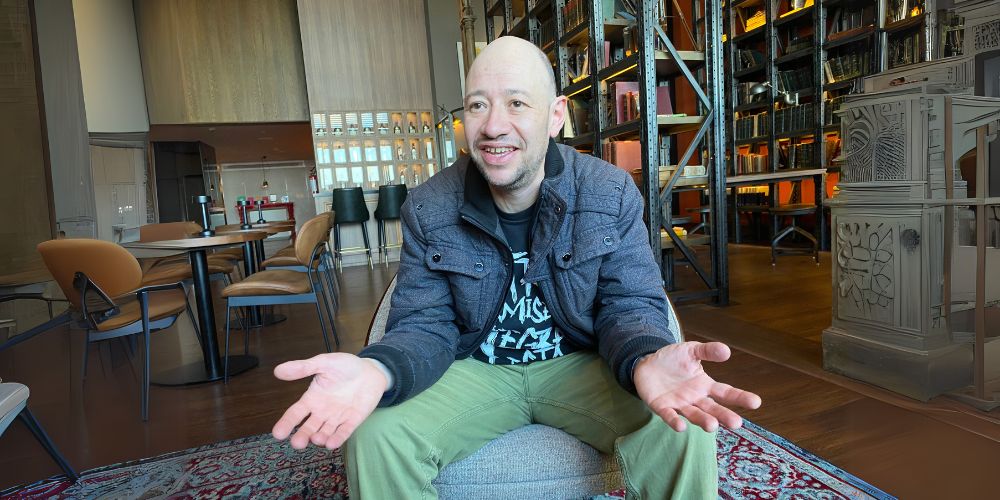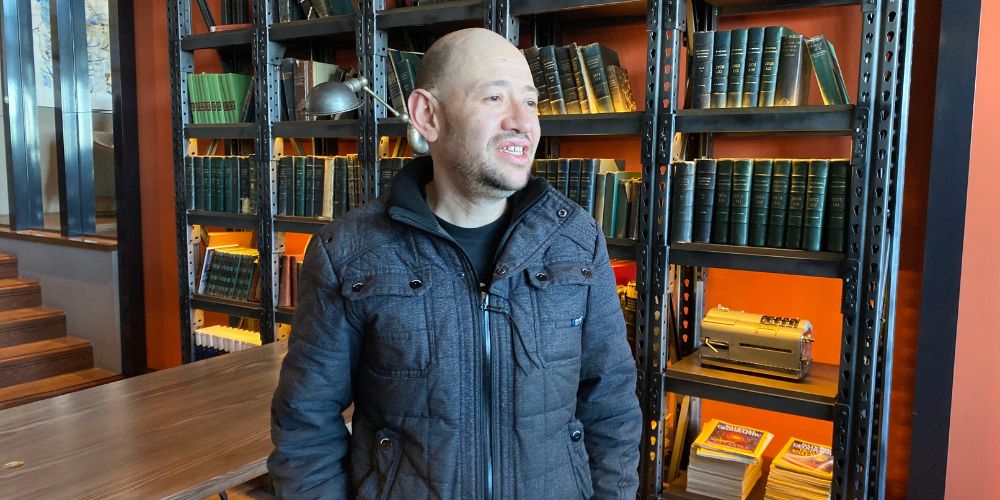- Home
- About us
- News
- Events
- EXPORT Export
-
BUY
Buy
BuyBuyFood and beverage Beef Caviar Dairy Products Fruits Healthy foods Olive oil Processed Foods Rice Sweets, honey and jams Wines ICT Software development Technology products
- INVEST Invest
- COUNTRY BRAND Country Brand
-
INFORMATION CENTER
Information center
InformationCenterInformationCenterReports Country reports Department reports Foreign trade reports Product-Destination worksheet Sectors reports Work documentsStatistical information Classification Uruguay XXI Exports Imports Innovative National Effort Macroeconomic Monitor Tools Buyers Exporters Investors
- Contact
-
Languages
“Uruguay has a very robust music industry, with extremely high standards of performance and production”
Héctor Mora, curator of Rock al Parque, visited Uruguay to attend Cosquín Rock with the support of Uruguay XXI and shared his thoughts on the scene, its identity, and future prospects
Share:

During Cosquín Rock Uruguay 2025, Uruguay XXI promoted an international mission that brought together festival programmers from across Latin America with artists from your local scene. Among them was Héctor Mora, curator of Rock al Parque, one of the most important festivals in the region. Mora toured Montevideo attentively—listening, taking notes, and connecting with an industry that, he says, surprised him with its professionalism, unique sound, and export potential.
In this interview, he highlights the vocal quality of Uruguayan artists, the melodic accessibility of your songs, and the emotional power of expressions like murga, which he describes as “an exercise in reading society.” He also underscores the structural strength of your music industry, which he considers more robust than that of many other countries on the continent.
—How was it to rediscover the Uruguayan scene on this visit, in the context of Cosquín Rock and the mission organized by Uruguay XXI?
I've been familiar with your rock tradition for many years. Last year, we hosted Buitres at Rock al Parque, and it was a moment of recognition for a band that has done it all in the history of Latin American rock. They were a key band that had never been part of the festival lineup, so it felt like we were making up for a long-standing debt.
That invitation was special because it opened the door to discovering new sounds. In Colombia, it’s not always easy to access music from Uruguay due to the distance. I think that’s begun to change in recent years thanks to the media and digital platforms, but even so, it’s still hard to discover bands beyond names like La Vela Puerca, Cuarteto de Nos, No Te Va Gustar, Buitres, or Trotsky Vengarán.
You have a very rich rock history, and this visit confirmed it. Thanks to Uruguay XXI’s support, I was able to see new projects that will allow us to discover more artists, expand our spectrum, and—as I often say—get the algorithms to start working in favor of this music. I’m leaving with questions, material to keep researching, and a strong desire to dive deeper into your scene.

—What differences did you notice between Uruguayan rock and other Latin American scenes?
On this visit, I saw other generations of musicians clearly reflecting contemporary stories and concerns in music and art. I’m starting to distinguish something in the contrast between your sound and Argentina’s.
There might be differences in accents, sure, but what I’m digging into now is structure. I’ve come to realize that Uruguayan rock is distinct—not just in tone or delivery, but in how you construct your narratives. There are vocal differences, yes, but I also notice that your storytelling feels more natural and relaxed, whether it’s punk, pop rock, or more elaborate indie.
People in Uruguay come across as warm and straightforward; emotions surface easily. Your songs reflect daily life, with very grounded references. They don’t try to reach for the abstract or complicate things unnecessarily. While some artists explore those dimensions, overall your lyrics feel lighter, more accessible—less burdened by pressure. That stands out to me.
Your songs seem crafted so that anyone can listen and relate. They connect easily across generations. Rather than referencing a specific era, they speak to timeless themes: life, love, everyday struggles.
—What role do historic Uruguayan bands play as references for the new generations?
When I talk to younger bands, there’s a clear sense of pride in your rock history. Many cite Buitres, Trotsky, Cuarteto de Nos, No Te Va Gustar, La Vela Puerca as influences. They’ve listened to them and, at some point, connected with their music.
That’s really important. Having established bands means there are role models—artists who’ve paved the way, set standards, and inspired those coming up. And inevitably, from a sound perspective, bands like these—active for decades, with many records—end up influencing how others write songs, whether through covers or by inspiring structural choices.
—What elements stood out to you in Uruguayan rock?
The song structures aren’t overly complicated. You’re not constantly changing bridges, or avoiding choruses, or adding sections that never repeat. Your songs are radio-friendly, and I think that’s important.
Vocal work in the Southern Cone is remarkable. Everyone has to sing well, and sometimes, further north on the continent, that gets overlooked. The importance of the voice and melodic development makes your music both easier to remember and more enjoyable for a wider audience.
All of that adds up—and you are who you are because of your history.
—Which bands surprised you at Cosquín Rock Uruguay, and what stood out about each?
What I saw in Uruguay was very diverse. For instance, there are acts that break away from the cliché of the passive singer-songwriter.
Flor Sakeo really caught my attention with a more aggressive style—there’s a stoner rock edge that gets dense and slow, but suddenly you get hints of punk and hard rock, with refined vocals and strong melodies.
Mentolados stood out with a type of indie rock that’s fresh, current, and very accessible. Mota was a revelation—I didn’t know them, but I’m a fan now. They’ve got raw energy, a sound that can travel, and they still carry a strong Uruguayan identity.
There’s so much variety. Manolo y los Vespass had a more neighborhood, alternative vibe. I also enjoyed discovering Abuela Coca. I’d heard the name but never listened properly. Now they’ve reunited, and I could sense how meaningful that was for people. You saw several generations celebrating. It’s a more classic kind of rock.
Eté y los Problems have a different approach—more melodic indie, intimate lyrics, reflective themes. I loved that too. Everything I saw was different and solid.
I also saw acts influenced by hip hop. And of course, the classics: Cuarteto de Nos, whom I already knew—huge in Colombia. Same with Trotsky Vengarán. But I had never seen La Vela Puerca live, even though they once played Rock al Parque. So I was able to cross off some of those essentials as well.
Slow Burnin’ was another highlight—more reggae and reggae-rock. So really, you have everything.

—What’s your impression of the structure and export potential of the Uruguayan music industry?
You have a very robust industry, with a sound that’s easy to connect with for anyone who speaks Spanish, and with a high level of production. Your artists consistently deliver strong compositions, performances, and stage presence.
Being a smaller country might mean your scene is more focused—and that also makes your exports more cohesive and easier to present abroad.
You have a major advantage there. Your network and industry structure are more solid than what we often see further north—not just in northern South America, but even up through Central America, close to Mexico.
You also have a refined lyrical culture, which helps a lot in markets like Spain. Like in Argentina, there’s a tradition of reading, of paying attention to lyrics, of writing well to express ideas. That lyrical richness is part of your identity, and it puts you at a very high level.
Your production quality is top-notch. There are Uruguayan producers known in Colombia. And I’m sure more artists and stories will emerge that give us new ways of seeing the world.
—What value did you find in meeting artists, managers, and agents from the Uruguayan industry during the business rounds?
I met a lot of people—bands, industry figures. You reconnect with those you may have worked with from afar, and connecting on a more human level is invaluable. In an age when everything’s digital and a bit impersonal, face-to-face trust is everything.
I made contacts with festivals, venues, and artists. We’ll see how that develops, in terms of distribution, promotion, production—that behind-the-scenes work that’s so crucial.
Cosquín Rock Uruguay and the business rounds were excellent. The production level was very high. Honestly, there’s nothing to envy from other industries on the continent.
There’s clear institutional support and a strong tradition in your country around this type of sound. It hasn’t been a marginal movement—at least not in recent years. Rock feels like part of your national story, and that’s key, because it’s what inspires the next generations.
You have musicians who’ve clearly dedicated their lives to rock—and that inspires others. Your production level is high, and in terms of international competitiveness, you’re easily on par with many other territories.
—What unexpected discovery did you take away from Cosquín Rock Uruguay—something you weren’t looking for but that left a mark?
Murga. Seeing Agarrate Catalina blew me away. It’s a choral and theatrical genre, but it felt like so much more—an exercise in reading society.
The place was packed, and somehow, everyone was united by this experience. Strangers standing together, singing songs from different generations, creating a shared moment. That’s what builds society. That’s what builds a city.
It was incredible. Everyone was singing along, happily. People knew they were part of something—even if they didn’t know where it was headed. It didn’t matter. They were going together. It was more than a band or a genre. It was a way of understanding the Uruguayan people through murga.
We already knew murga was famous internationally, but this gave me a much more human perspective. I didn’t expect such powerful moments. The music industry can be cold at times, but when you find something that connects people like that, you realize: this is identity. This is what gives music meaning.
Every country has stories to tell, songs to share. We’re all playing the same chords in different arrangements. But it’s that distinct cultural lens—that storytelling voice—that gives your rock its soul. That’s what I experienced here.
—What image are you taking away from Uruguay as a country, and what do you think it contributes to Latin American culture?
The country’s development is clear. You have the largest middle class in Latin America, and an economic model that many others envy. Your public policies have often been cutting-edge.
Uruguay’s legacy—as a nation and in cultural contribution—is unique in Latin America. And it’s inspiring for many of us.
That’s what I’m taking away: motivation, hope, positive energy. I’m leaving with new ideas, fresh inspiration, and a lot of projects in mind.
FEATURED NEWS:
- Flor Sakeo: Graffiti’s Best Female Solo Artist Takes Her Talent to Chile with Uruguay XXI’s Support
- Cosquín Rock: un escaparate para que la música uruguaya llegue a mercados internacionales
- Soñar Robots joins Deutsche Welle’s international catalog, expanding the global reach of Uruguayan documentary film
